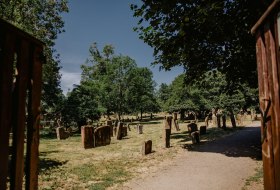
searchMenu




The building complex, constructed in the 13th century, was the nucleus of the Rhenish Palsgraviate and secondary residence and headquarters of the district administration. The castle of Alzey was a favoured place of residence for the Palsgraves during the time of both Ruprechten, Ruprecht ll. and Ruprecht lll. who was King Ruprecht I. of Germany from 1400 - 1410.…

Waldthausen Castle, a masterpiece of architecture in the heart of the Lenneberg Forest near Mainz, tells the story of a visionary builder, Martin Wilhelm von Waldthausen. Amidst a 95-hectare area acquired by the municipality of Budenheim in 1908, the magnificent villa was constructed in 1910. The architectural design, implemented by Hans Bühling, was inspired by Staufen palace buildings and continues to shape the property to this day. The castle, in all its splendor, is surrounded by an extensive park and terraced gardens once designed…

In July 2021, the cities of Worms, Speyer and Mainz were awarded the title of World Heritage Site by UNESCO for their ShUM sites. The cities are considered the cradle of Ashkenazi Judaism. Discover the Jewish monuments in Worms and their significance for the cultural heritage on this guided tour. You will visit the oldest preserved Jewish cemetery in situ in Europe, the ‘Holy Sand’, as well as the former Jewish quarter in the Judengasse with the synagogue. The monuments illustrate Jewish life in the city and, together with the…


water house Built for water supply for Westhofen Art Nouveau in 1905. In the 1960 the pressure did not increase and was shut down. History and stories Visible from afar, the water house from 1905, built in Art Nouveau style, reflects the self-image of the time. William II strove for the great power, rearmed, annexed land overseas and built. The buildings always represented the thinking of the time and their rulers; so also our water house, although actually uninteresting to represent. In the 1960s, a…

The history of the Deutschherrenhof cultural monument dates back to the 15th century.